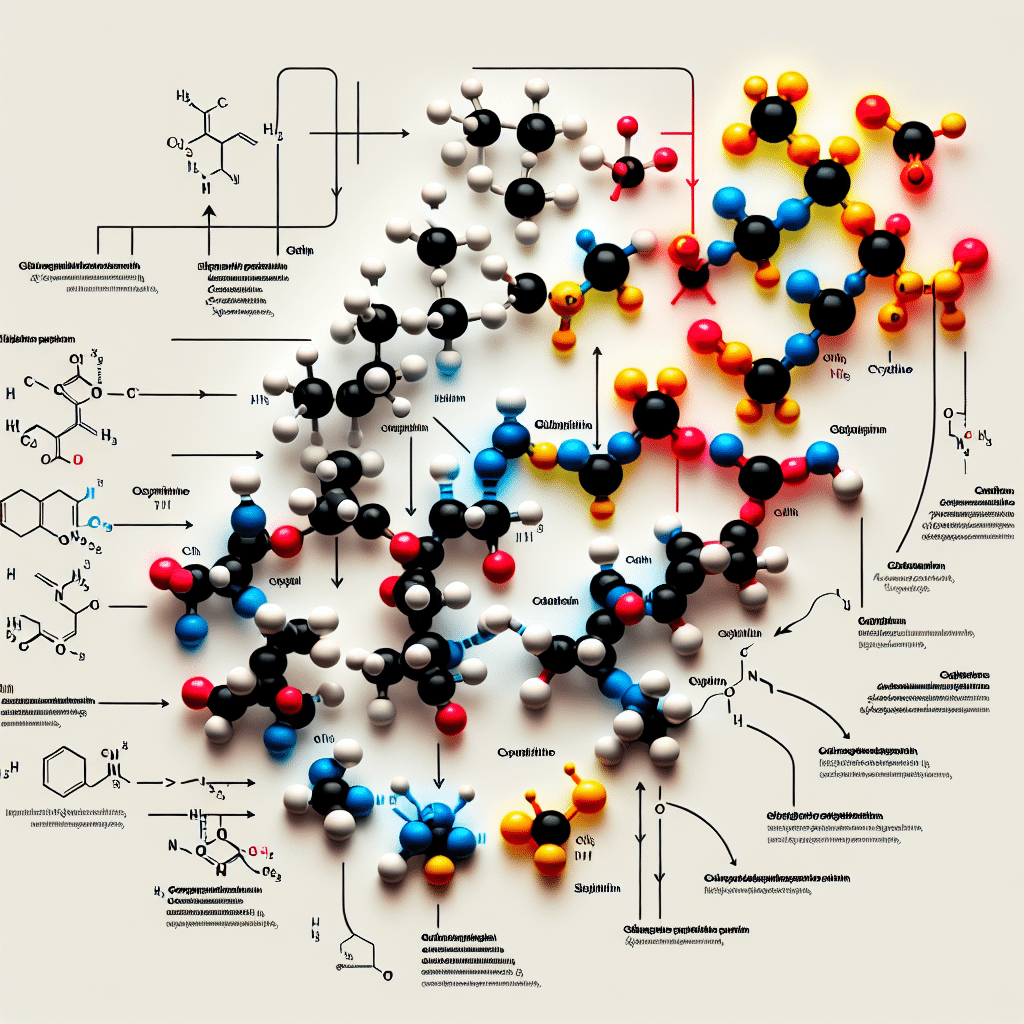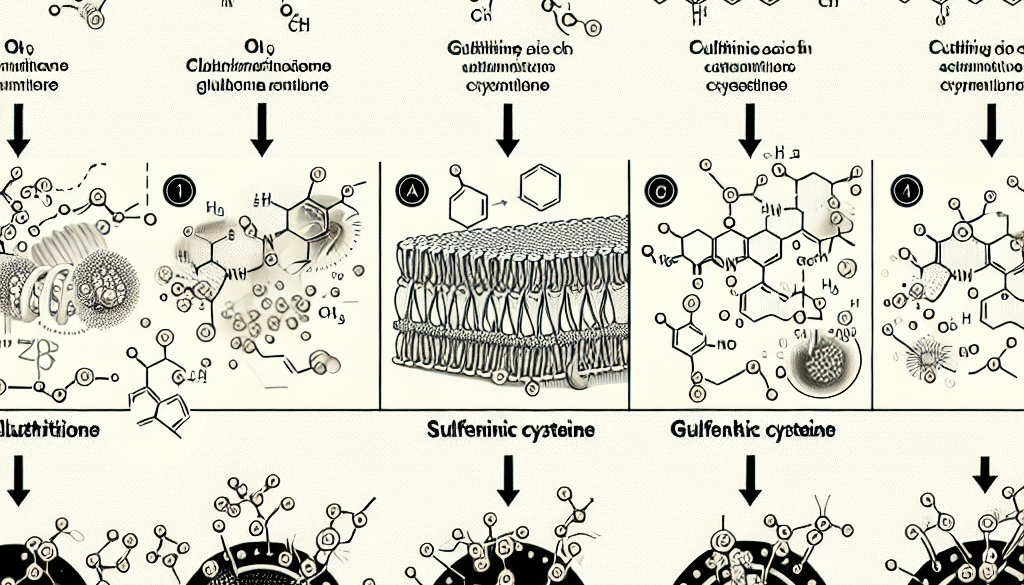Glutathione React with Sulfenic Cysteine: Explained
-
Table of Contents
- Glutathione and Sulfenic Cysteine Interactions: A Detailed Exploration
- Understanding Glutathione’s Role in Cellular Protection
- The Chemistry of Sulfenic Cysteine
- Glutathione Reacts with Sulfenic Cysteine: The Mechanism
- Biological Implications of Glutathione-Sulfenic Cysteine Interactions
- Case Studies and Research Findings
- Conclusion: Key Takeaways on Glutathione and Sulfenic Cysteine
- Enhance Your Health with ETprotein’s Premium Protein Products
Glutathione and Sulfenic Cysteine Interactions: A Detailed Exploration

Glutathione, a tripeptide consisting of glutamine, cysteine, and glycine, is a crucial antioxidant in cells, playing a vital role in maintaining the redox state and detoxifying harmful substances. Sulfenic cysteine, on the other hand, is a modified form of the amino acid cysteine, which contains a sulfenic acid group (-SOH). The interaction between glutathione and sulfenic cysteine is a fundamental process in cellular biology, particularly in the context of protein function and signaling. This article delves into the chemistry behind this interaction and its implications for cellular health and disease.
Understanding Glutathione’s Role in Cellular Protection
Glutathione (GSH) is often referred to as the body’s master antioxidant. It is found in virtually all cells and is essential for protecting them against oxidative stress. Oxidative stress occurs when there is an imbalance between the production of reactive oxygen species (ROS) and the body’s ability to detoxify these harmful compounds or repair the resulting damage.
- GSH neutralizes ROS such as free radicals, peroxides, and heavy metals.
- It regenerates other antioxidants, such as vitamins C and E, back to their active forms.
- GSH is involved in the synthesis and repair of DNA, as well as the activation and regulation of enzymes.
- It plays a critical role in the immune response by promoting the proliferation of lymphocytes, the cells that mediate the body’s immune response.
The Chemistry of Sulfenic Cysteine
Sulfenic cysteine residues are formed in proteins when the thiol group of cysteine is oxidized to form a sulfenic acid group. This can occur through various mechanisms, including the direct reaction with ROS or as a result of enzymatic activity. Sulfenic cysteine plays a significant role in cellular signaling and regulation:
- It acts as a sensor for oxidative stress, altering the function of proteins in response to changes in the cellular redox state.
- Sulfenic cysteine can form disulfide bonds with other cysteine residues, leading to changes in protein structure and function.
- It can also react with nitrogen species to form S-nitrosothiols, which are involved in nitric oxide signaling.
Glutathione Reacts with Sulfenic Cysteine: The Mechanism
The reaction between GSH and sulfenic cysteine is a key step in the process known as the redox regulation of proteins. When a protein’s cysteine residue is oxidized to sulfenic acid, it can be a reversible modification if GSH is available to react with it. The reaction between GSH and sulfenic cysteine is termed glutathionylation, and it results in the formation of a mixed disulfide bond between GSH and the protein. This process serves several important functions:
- It protects the sulfenic cysteine from further oxidation to irreversible states such as sulfinic (-SO2H) or sulfonic acid (-SO3H).
- Glutathionylation can modulate the activity of proteins, often inhibiting their function until the reducing environment of the cell is restored.
- It serves as a mechanism for signal transduction, as the addition or removal of GSH can alter protein function and thus cellular processes.
Biological Implications of Glutathione-Sulfenic Cysteine Interactions
The interaction between GSH and sulfenic cysteine has profound implications for health and disease. Aberrations in this process can lead to a variety of disorders:
- Oxidative stress-related diseases such as cancer, cardiovascular diseases, and neurodegenerative disorders like Alzheimer’s and Parkinson’s disease.
- Impaired immune function, as proper redox regulation is essential for the optimal activity of immune cells.
- Chronic inflammation, which is often associated with an imbalance in redox signaling and glutathione levels.
Case Studies and Research Findings
Research has provided insights into the importance of glutathione-sulfenic cysteine interactions. For instance, studies have shown that:
- Glutathionylation of the transcription factor NF-kB, which plays a key role in inflammatory responses, can inhibit its ability to bind DNA and thus reduce the expression of pro-inflammatory genes.
- Proteins involved in mitochondrial function can be regulated by glutathionylation, affecting energy production and apoptosis (programmed cell death).
- Glutathionylation of ion channels and transporters can influence their activity, impacting cellular processes such as muscle contraction and neurotransmission.
Conclusion: Key Takeaways on Glutathione and Sulfenic Cysteine
In conclusion, the interaction between glutathione and sulfenic cysteine is a critical aspect of cellular function. It represents a protective mechanism against oxidative damage, a regulatory switch for protein function, and a signaling pathway for the cell to respond to its environment. Understanding this interaction is essential for developing therapeutic strategies to combat diseases associated with oxidative stress and redox imbalance.
Enhance Your Health with ETprotein’s Premium Protein Products
If you’re looking to support your body’s antioxidant defenses and overall health, consider incorporating high-quality protein products from ETprotein into your diet. ETprotein offers a range of organic, non-GMO, allergen-free protein powders that can complement your nutritional needs and help maintain optimal glutathione levels.
About ETprotein:
ETprotein, a reputable protein and L-(+)-Ergothioneine (EGT) Chinese factory manufacturer and supplier, is renowned for producing, stocking, exporting, and delivering the highest quality organic bulk vegan proteins and L-(+)-Ergothioneine. They include Organic rice protein, clear rice protein, pea protein, clear pea protein, watermelon seed protein, pumpkin seed protein, sunflower seed protein, mung bean protein, peanut protein, and L-(+)-Ergothioneine EGT Pharmaceutical grade, L-(+)-Ergothioneine EGT food grade, L-(+)-Ergothioneine EGT cosmetic grade, L-(+)-Ergothioneine EGT reference grade and L-(+)-Ergothioneine EGT standard. Their offerings, characterized by a neutral taste, non-GMO, allergen-free attributes, with L-(+)-Ergothioneine purity over 98%, 99%, cater to a diverse range of industries. They serve nutraceutical, pharmaceutical, cosmeceutical, veterinary, as well as food and beverage finished product distributors, traders, and manufacturers across Europe, USA, Canada, Australia, Thailand, Japan, Korea, Brazil, and Chile, among others.
ETprotein specialization includes exporting and delivering tailor-made protein powder and finished nutritional supplements. Their extensive product range covers sectors like Food and Beverage, Sports Nutrition, Weight Management, Dietary Supplements, Health and Wellness Products, and Infant Formula, ensuring comprehensive solutions to meet all your protein needs.
As a trusted company by leading global food and beverage brands and Fortune 500 companies, ETprotein reinforces China’s reputation in the global arena. For more information or to sample their products, please contact them and email sales(at)ETprotein.com today.










